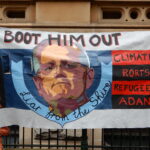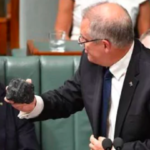PM Facilitates Green Energy for Singapore and Gas for Australia: An Interview with 350’s Lucy Manne

The sequence of events is well known. Over the summer of 2019-20, Australia suffered its worst bushfire season ever. This occurred at the same time as extreme climate-driven weather events were steadily increasing around the planet.
In February last year, as the last bushfire flames were still being put out, prime minister Scott Morrison appointed Keith Pitt as resource minister. And obviously not being big on the scientific evidence behind the climate crisis, Pitt called for further investment in coal, gas and even uranium.
Then the COVID-19 pandemic kicked in. The PM established a corporate-led body to steer our economy out of the health crisis. And on 15 September 2020, Morrison announced that our nation would be taking a “gas-fired recovery” to advance economic “bounce back”.
However, as 350 Australia reported in February, this isn’t an ideal solution. The environmental organisation points out that the government subsidised recovery plan – which involves the opening of five gas basins – would cause the nation’s greenhouse gas emissions to triple.
Going green on NT soil
Contrast the Australian government’s plans with that of its counterpart in Singapore. Our Southeast Asian neighbour is making a huge investment in solar energy, with the aim of fuelling up to 20 percent of its energy needs in six years’ time.
In order to do this, Singapore gas firm Sun Cable is building the world’s largest solar powerplant in the North Territory. That’s right, the Australia-ASEAN Power Link is going to produce renewable electricity to be transported via undersea cable to assist another nation in going green.
The NT government and Singapore signed an agreement in January, which will see Australia’s largest renewable energy infrastructure project located close to Tennant Creek, generate $8 billion for the local economy and see $1 billion worth of electricity exported annually.
The project was first announced in 2019. And in July last year, right before the gas-led recovery announcement, the Morrison government moved to fast track the project by awarding it a special status.
And two of Australia’s richest people, Mike Cannon-Brookes and Andrew Forrest, have also provided support to the project.
Fracking the NT
The fossil fuel-based economic recovery path that the Coalition government has set out for the domestic sphere involves opening up gas basins in North Bowen, Galilee, Gunnedah, Perth and Beetaloo in the Northern Territory.
350 Australia chief executive officer Lucy Manne reported last week that she’d been watching Sydney-based company Energy Empire explain to parliament how it plans to frack the Beetaloo Basin, which is being facilitated by a $21 million grant that minister Pitt awarded the company.
Sydney Criminal Lawyers spoke to 350 Australia’s Lucy Manne about the spate of extreme weather events currently happening in the northern hemisphere, the hypocrisy surrounding the Singapore green energy deal and why keeping below 1.5°C above the pre-industrial level is still the priority.
Last Wednesday, you learnt about how oil and gas company Empire Energy plans to frack gas in the Beetaloo Basin in the Northern Territory. Lucy, what does this proposal involve? And why is it an issue?
The Beetaloo Basin is a large shale gas resource in the Northern Territory. It covers about 28,000 square kilometres of Aboriginal and pastoral lands. And there are a whole lot of companies that for a long time have been wanting to frack it.
That includes big companies, like Origin Energy and Santos, as well as smaller players that want to explore, like Empire Energy, which has just got this $21 million grant.
The problem is it’s a shale gas resource, so it will require fracking to develop it. That’s the method of gas extraction that’s really damaging. It puts the environment and water at risk, and, of course, any gas extraction will also fuel dangerous climate change.
We know we can’t afford to open up any new oil and gas basins. And we know from our 350 analysis that this basin has the potential to produce emissions of 393 megatons, which is about 24 times the North Territory’s annual emissions.
Beetaloo Basin is fiercely opposed across the NT. That’s by traditional owners, community members and environment and climate groups.
That’s why it’s particularly outrageous that not only are companies being allowed to start testing there, but the government is actually giving them public money in order to accelerate the program.
So, Empire Energy was just given the $21 million grant to accelerate its fracking, and what makes this even more concerning and questionable is that the chair of Empire Energy is a well-known Liberal Party figure and donor.
There are a lot of concerns about this. Certainly, in the Beetaloo Basin, the gas has to remain in the ground. That’s what we need for a safe climate.
Meanwhile, as the Morrison government facilitates this, there’s been a rise in extreme weather events occurring in the northern hemisphere. This spate has left scientists somewhat baffled, as no modelling had predicted it.
We’ve been rather sheltered from the news of this in Australia due to the focus on the pandemic, but how would you describe what’s going on in the north?
We’ve just seen a huge number of deadly climate-driven disasters. There’s been awful flash flooding in Europe and Asia. There have been intense heatwaves, wildfires and droughts.
Just recently, there has been footage coming out of Turkey, where we’re seeing intense wildfires.
What it’s demonstrating is the urgency of the issue. There is no time to waste.
We know from the best science and modelling that we can’t afford to burn anymore fossil fuels. We need to transition towards renewable energy as soon as possible.
It’s a stark reminder of the urgency of this issue. Every fraction of a degree that we continue to warm the planet, will lead to more intense and frequent climate disasters.
Our nation only has to cast its mind back a year and a half ago to find such an extreme weather event on our doorstep with the 2019-20 bushfire season.
Straight after this, Morrison unleashed his gas-led recovery, which involves not only the Beetaloo Basin, but the opening up of four other gas fields.
In your opinion, what does it mean for the government to take a fossil fuel-based road to economic recovery at this point in the climate crisis?
The Morrison government is really using COVID as cover in order to give handouts to the fossil fuel industry. There is a long history of governments in Australia giving subsidies to fossil fuels – to coal and gas in particular – and this has been no exception.
He’s claimed that it’s to do with the economy during COVID. But we know that the opening up of new gas basins and power stations will not only fuel dangerous climate impacts, but it’s also an ineffective way of supporting jobs in the economy.
Gas is one of the least job intensive industries out there. For every dollar you spend on the gas industry, you create far less jobs than a dollar you spend on many other industries.
If you look at the industries that really need support right now, it’s hospitality, care work, and tourism. All these industries need a boost.
In fact, Empire Energy recently admitted in a Senate inquiry that they only employ eight people in Australia.
This really underlines why we need public investment in areas that create lots of new jobs in sustainable industries, where the investment will go further and also go towards tackling climate change.
Rather than facilitating our nation to turn towards renewable energy, the Morrison government is instead greenlighting plans for solar power company Sun Cable to build the world’s largest solar power plant close to Darwin, so it can power 20 percent of Singapore’s energy needs by 2027.
How would you sum up the coupling of permitting Singapore to go green via renewable infrastructure built on Australian soil, whilst pushing for more fossil fuel power infrastructure for the local market?
Encouraging the export of renewable energy is great. But you are right, the issue is that we’re not actually doing that in Australia with our domestic energy. This means that we risk falling behind the rest of the world.
If you look at reports from groups like WWF, it shows we could become a renewable energy superpower, so we aren’t just 100 percent powered by renewable energy, but 700 percent powered by renewable energy by 2050.
Not only would we get all our domestic energy from renewables, but we’d also export things like hydrogen, or, like the Sun Cable project, renewable energy itself. Then we can also export parts for renewable energy manufacturing and engineering skills.
So, it’s good to be exporting renewables. But it needs to be a holistic change where we transform our domestic system, create lots of jobs, and then we can export as well.
Evidence ANU Earth Science Professor Will Steffen recently provided the Federal Court outlined that the Paris Agreement target of keeping below 1.5°C above the pre-industrial level is now unlikely.
Many governments still refer to this target as their goal. In your understanding, what is humanity chasing now in terms of an achievable slowing down of the climate emergency?
We’ve known for a long time that 1.5 degrees is a really challenging goal, but also, it’s absolutely essential to avoid the impacts of climate change.
What we know is that every day we continue to delay the transition from fossil fuels to renewable energy, we are making it even harder to prevent reaching 1.5 degrees of warming.
Every coal fired power station that stays open longer, every new coal mine and every new gas well – all of the new fossil fuel infrastructure – is warming the planet. We have already warmed the planet by 1°C.
We need to think about it in terms of how every fraction of a degree leads to damaging impacts and we need to rapidly make that shift. We should not be opening up any new fossil fuel reserves whatsoever.
The science clearly shows that we can’t afford to do that if we are going to have a chance of keeping below 1.5°C.
Professor Steffen gave this evidence in relation to the Sharma case, which led the court to issue a declaration that the federal environment minister has a duty of care “to avoid causing personal injury or death” to children residing in Australia, when considering the approval of fossil fuel projects.
If this decision isn’t overturned on appeal, how significant do you think it will be?
It’s really significant. At the moment, with the approvals for these gas and oil projects that fuel dangerous climate change, the environment minister doesn’t have to factor that duty of care around the impacts for children and future generations.
It means that if the government breaches that duty of care and doesn’t consider the impacts of climate change on children, there will be avenues that can be pursued in response.
It’s an important decision. And I’m sure there are going to be more cases like it, which demonstrate the important moral and also now legal requirement of the minister and the government to take into account the impacts on children and those most impacted by climate change.
And lastly, Lucy, from the perspective of 350 Australia how should this nation be responding to the climate emergency right now? And do we have time to put this action on the backburner whilst we deal with the COVID pandemic?
When you look at the responses to the COVID pandemic that have occurred, it’s been critical to put the medical response front and centre.
But in terms of responding to the economic fallout, the need to create more jobs and stimulate economic growth, what we are seeing around the world that we could learn from in Australia is looking at recovery spending that invests in renewable energy jobs and other sustainable industries.
What that does is it tackles the two crises at once. We can tackle the economic fallout of the COVID crisis and climate change at the same time.
It’s a huge opportunity to spend on projects that would address climate change and build on renewable energy. At the same time, it would be creating lots of those jobs for people who need them.
So, it’s about looking at how we are going to tackle these two challenges together, as that’s how we are going to get the best response.







